Performance Analysis of Dual-Hop DF Multi-Relay FSO System with Adaptive Modulation
Abstract
:1. Introduction
2. Description of the System
3. Adaptive Modulation Technique
4. The Performance Analysis of Dual-Hop Single-Relay System
4.1. Modulation Level Selection Probability
4.2. Spectral Efficiency
4.3. Outage Probability
5. The Performance Analysis of Dual-Hop Multi-Relay System
5.1. Optimal Relay Selection Scheme: S-R-D Link
5.2. Suboptimal Relay Selection Scheme: S-R Link
5.3. Suboptimal Relay Selection Scheme: R-D Link
6. Numerical Results
7. Conclusions
Author Contributions
Funding
Institutional Review Board Statement
Informed Consent Statement
Data Availability Statement
Acknowledgments
Conflicts of Interest
Nomenclature
| Symbol | Definition |
| L | Number of relays |
| Pointing errors parameter | |
| Gamma function | |
| a | Fading parameter related to smal-scale normalized variance |
| b | Fading parameter related to large-scale normalized variance |
| Meijer G function | |
| Instantaneous SNR | |
| Average SNR | |
| Modulation level | |
| N | Number of modulation levels |
| Modulation level selection probability | |
| S | Spectral Efficiency |
| Transmission bit rate | |
| W | Bandwidth |
| Outage probability | |
| Target ABER | |
| k | Selected relay |
References
- Chowdhury, M.Z.; Shahjalal, M.; Hasan, M.K.; Jang, Y.M. The Role of Optical Wireless Communication Technologies in 5G/6G and IoT Solutions: Prospects, Directions, and Challenges. Appl. Sci. 2019, 9, 4367. [Google Scholar] [CrossRef]
- Aboelala, O.; Lee, I.E.; Chung, G.C. A Survey of Hybrid Free Space Optics (FSO) Communication Networks to Achieve 5G Connectivity for Backhauling. Entropy 2022, 24, 1573. [Google Scholar] [CrossRef]
- Peppas, K.P.; Alexandropoulos, G.C.; Xenos, E.D.; Maras, A. The Fischer–Snedecor F-Distribution Model for Turbulence-Induced Fading in Free-Space Optical Systems. J. Light. Technol. 2020, 38, 1286–1295. [Google Scholar] [CrossRef]
- Le-Tran, M.; Kim, S. Performance Analysis of Dual-Hop FSO Cooperative Systems over F Turbulence with Pointing Errors. Photonics 2022, 9, 437. [Google Scholar] [CrossRef]
- Yu, X.; Xu, G.; Zhang, Q.; Song, Z. Dual-Hop Optical Communication Systems over Málaga Turbulence under Pointing Error Impairments with Decode-and-Forward Protocol. IEEE Photonics J. 2022, 14, 1–15. [Google Scholar] [CrossRef]
- Deka, R.; Sipani, J.; Anees, S. On the Performance of a HAPS Assisted AF Based Dual-hop FSO Communication System. In Proceedings of the International Conference on Wireless Communications Signal Processing and Networking (WiSPNET), Chennai, India, 24–26 March 2022; pp. 13–18. [Google Scholar]
- Wang, J.; Xu, G.; Zhao, Z.; Xu, M.; Yu, X.; Zhang, Q. Performance Analysis of Dual-Hop UAV-Assisted FSO Communication System with DF Protocol. In Proceedings of the 14th International Conference on Wireless Communications and Signal Processing (WCSP), Nanjing, China, 1–3 November 2022; pp. 900–904. [Google Scholar]
- Joshi, H.; Gupta, S. On the performance of dual-hop mixed RF and hybrid RF-FSO relaying. Opt. Quantum Electron. 2023, 55, 803. [Google Scholar] [CrossRef]
- Ding, J.; Xie, X.; Wang, L.; Tan, L.; Ma, J.; Kang, D. Performance of dual-hop FSO/RF systems with fixed-gain relaying over Fisher–Snedecor and κ-μ shadowed fading channels. Appl. Opt. 2022, 61, 2079. [Google Scholar] [CrossRef]
- Singh, D.; Swaminathan, R. Comprehensive performance analysis of hybrid FSO/RF space–air–ground integrated network. Opt. Commun. 2023, 527, 128964. [Google Scholar] [CrossRef]
- Odeyemi, K.O.; Owolawi, P.A. A mixed FSO/RF integrated satellite-high altitude platform relaying networks for multiple terrestrial users with presence of eavesdropper: A secrecy performance. Photonics 2022, 9, 32. [Google Scholar] [CrossRef]
- Zhou, S.H.; Ding, D.; Wang, J.; Li, Y.; Yang, D.; Bai, C. Performance analysis of hybrid FSO-UWOC dual-hop link for air-ocean communication. In Proceedings of the Eighth Symposium on Novel Photoelectronic Detection Technology and Applications, Kunming, China, 9–11 November 2021; p. 219. [Google Scholar]
- Jurado-Navas, A.; Álvarez Roa, C.; Álvarez Roa, M.; Castillo-Vázquez, M. Cooperative Terrestrial-Underwater Wireless Optical Links by Using an Amplify-and-Forward Strategy. Sensors 2022, 22, 2464. [Google Scholar] [CrossRef]
- Ali, M.F.; Jayakody, D.N.K.; Garg, S.; Kaddoum, G.; Hossain, M.S. Dual-Hop Mixed FSO-VLC Underwater Wireless Communication Link. IEEE Trans. Netw. Serv. Manag. 2022, 19, 3105–3120. [Google Scholar] [CrossRef]
- Yang, L.; Zhu, Q.; Yan, X.; Li, S.; Jiang, H. Performance Analysis of Mixed PLC-FSO Dual-Hop Communication Systems. IEEE Internet Things J. 2022, 9, 19307–19317. [Google Scholar] [CrossRef]
- Safari, M.; Uysal, M. Relay-assisted Free-space optical communication. IEEE Trans. Wirel. Commun. 2008, 7, 5441–5449. [Google Scholar] [CrossRef]
- Abou-Rjeily, C.; Slim, A. Cooperative Diversity for Free-Space Optical Communications: Transceiver Design and Performance Analysis. IEEE Trans. Commun. 2011, 59, 658–663. [Google Scholar] [CrossRef]
- Molla Aghajanzadeh, S.; Uysal, M. Performance Analysis of Parallel Relaying in Free-Space Optical Systems. IEEE Trans. Commun. 2015, 63, 4314–4326. [Google Scholar] [CrossRef]
- Wang, Y.; Du, W. Performance analysis of amplify and forward parallel relaying free-space optical system over distribution. Opt. Eng. 2020, 59, 1. [Google Scholar] [CrossRef]
- Chatzidiamantis, N.D.; Michalopoulos, D.S.; Kriezis, E.E.; Karagiannidis, G.K.; Schober, R. Relay selection in relay-assisted free space optical systems. In Proceedings of the IEEE Global Telecommunications Conference-GLOBECOM, Houston, TX, USA, 5–9 December 2011; pp. 1–6. [Google Scholar]
- Bhatnagar, M.R. Average BER analysis of relay selection based decode-and-forward cooperative communication over Gamma-Gamma fading FSO links. In Proceedings of the IEEE International Conference on Communications (ICC), Budapest, Hungary, 9–13 June 2013; pp. 3142–3147. [Google Scholar]
- Puri, P.; Garg, P. Relay selection strategy for parallel relayed FSO systems. In Proceedings of the IEEE 28th Annual International Symposium on Personal, Indoor, and Mobile Radio Communications (PIMRC), Montreal, QC, Canada, 8–13 October 2017; pp. 1–5. [Google Scholar]
- Taher, M.A.; Abaza, M.; Fedawy, M.; Aly, M.H. Relay selection schemes for FSO communications over turbulent channels. Appl. Sci. 2019, 9, 1281. [Google Scholar] [CrossRef]
- Agarwal, D.; Bansal, A.; Kumar, A. Partial CSI based Relay Selection for TWR-FSO over Unified Exponentiated Weibuill links. In Proceedings of the International Conference on Signal Processing and Communications (SPCOM), Bangalore, India, 16–19 July 2018; pp. 497–501. [Google Scholar]
- Milic, D.; Smilic, M.; Nikolic, B.; Tuba, M.; Spalevic, P. Capacity of Adaptive Free Space Optical Transmission over Malaga Turbulence with Pointing Error using Truncated Channel Inversion. In Proceedings of the 7th International Symposium on Digital Forensics and Security (ISDFS), Barcelos, Portugal, 10–12 June 2019; pp. 1–6. [Google Scholar]
- Smilić, M.; Nikolić, Z.; Milić, D.; Spalević, P.; Panić, S. Comparison of adaptive algorithms for free space optical transmission in Málaga atmospheric turbulence channel with pointing errors. IET Commun. 2019, 13, 1578–1585. [Google Scholar] [CrossRef]
- Hariq, S.H.; Odabasioglu, N. Link Adaptation Algorithms for Free-Space Optical Communication Systems. In Proceedings of the IEEE International Conference on Advanced Networks and Telecommunications Systems (ANTS), Gandhinagar, India, 18–22 December 2019; pp. 1–5. [Google Scholar]
- Chatzidiamantis, N.D.; Lioumpas, A.S.; Karagiannidis, G.K.; Arnon, S. Adaptive subcarrier PSK intensity modulation in free space optical systems. IEEE Trans. Commun. 2011, 59, 1368–1377. [Google Scholar] [CrossRef]
- Hassan, M.Z.; Hossain, M.J.; Cheng, J. Performance of non-adaptive and adaptive subcarrier intensity modulations in gamma-gamma turbulence. IEEE Trans. Commun. 2013, 61, 2946–2957. [Google Scholar] [CrossRef]
- Saber, M.J.; Keshavarz, A. On performance of adaptive subcarrier intensity modulation over generalized FSO links. In Proceedings of the Iranian Conference on Electrical Engineering (ICEE), Mashhad, Iran, 8–10 May 2018; pp. 358–361. [Google Scholar]
- Chen, D.; Huang, G.; Liu, G.; Lei, Y. Performance of adaptive subcarrier modulated MIMO wireless optical communications in Malaga turbulence. Opt. Commun. 2019, 435, 265–270. [Google Scholar] [CrossRef]
- Alathwary, W.A.; Altubaishi, E.S. Performance of coherent FSO systems with adaptive M-PSK modulation. Opt. Laser Technol. 2024, 168, 109990. [Google Scholar] [CrossRef]
- Nouri, H.; Uysal, M. Adaptive free space optical communication system with multiple apertures. In Proceedings of the 24th Signal Processing and Communication Application Conference (SIU), Zonguldak, Turkey, 16–19 May 2016; pp. 937–940. [Google Scholar]
- Nouri, H.; Sait, S.M.; Uysal, M. Adaptive Modulation for FSO IM/DD Systems with Multiple Transmitters and Receivers. IEEE Commun. Lett. 2022, 27, 586–590. [Google Scholar] [CrossRef]
- Alheadary, W.G.; Park, K.H.; Alouini, M.S. Performance analysis of multihop heterodyne free-space optical communication over general Malaga turbulence channels with pointing error. Optik 2017, 151, 34–47. [Google Scholar] [CrossRef]
- Sipahioglu, F.; Ozduran, V.; Yarman, S.B. An Adaptive Modulation for Relay-Assisted Wireless Optical Network. In Proceedings of the Advances in Wireless and Optical Communications (RTUWO), Riga, Latvia, 15–16 November 2018; pp. 6–11. [Google Scholar]
- Badarneh, O.S.; Derbas, R.; Almehmadi, F.S.; El Bouanani, F.; Muhaidat, S. Performance Analysis of FSO Communications Over F Turbulence Channels with Pointing Errors. IEEE Commun. Lett. 2021, 25, 926–930. [Google Scholar] [CrossRef]
- Prudnikov, A.; Brychkov, Y.; Marichev, O. Integrals and Series. Volume 3: More Special Functions; Gordon and Breach: London, UK, 1989. [Google Scholar]

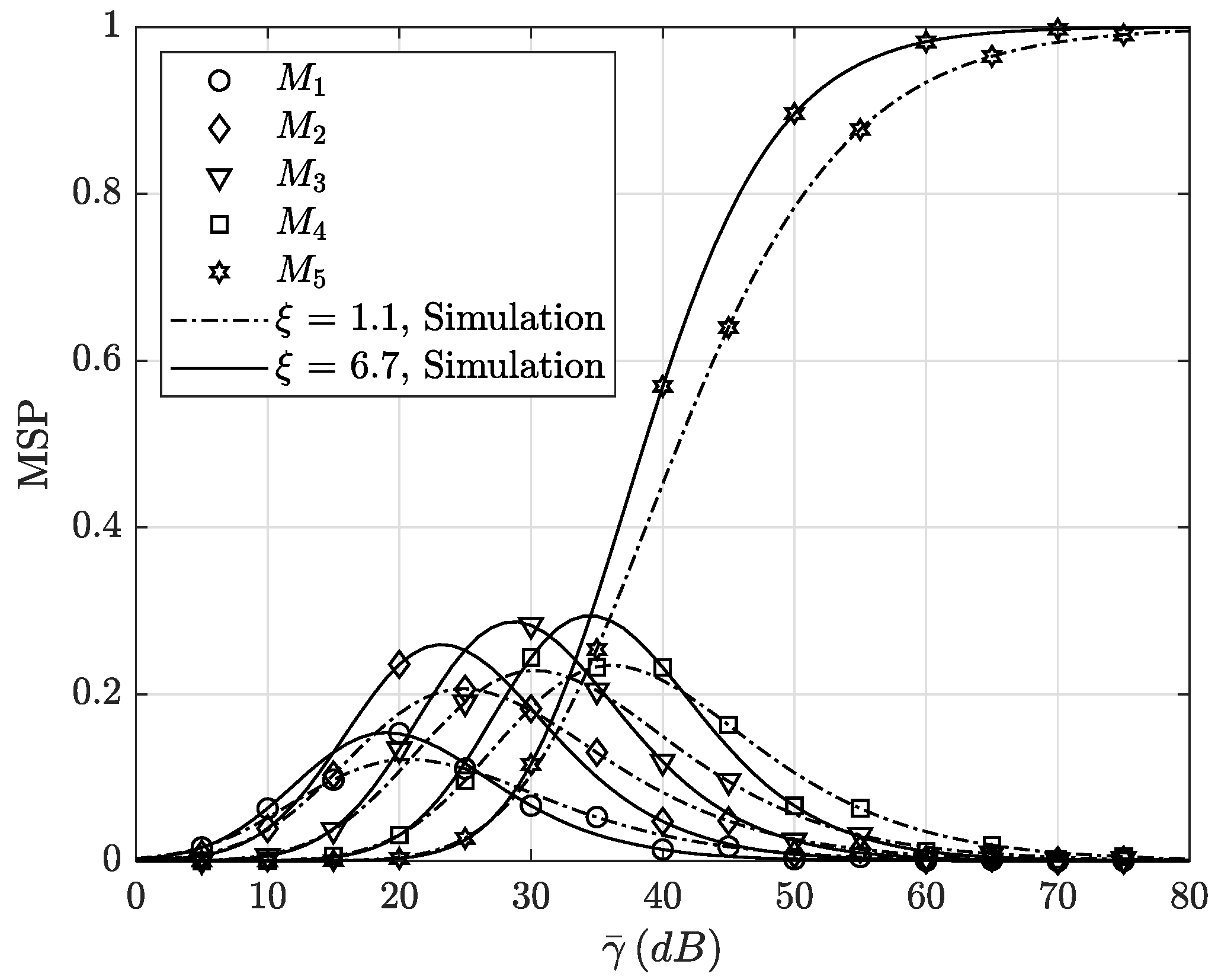
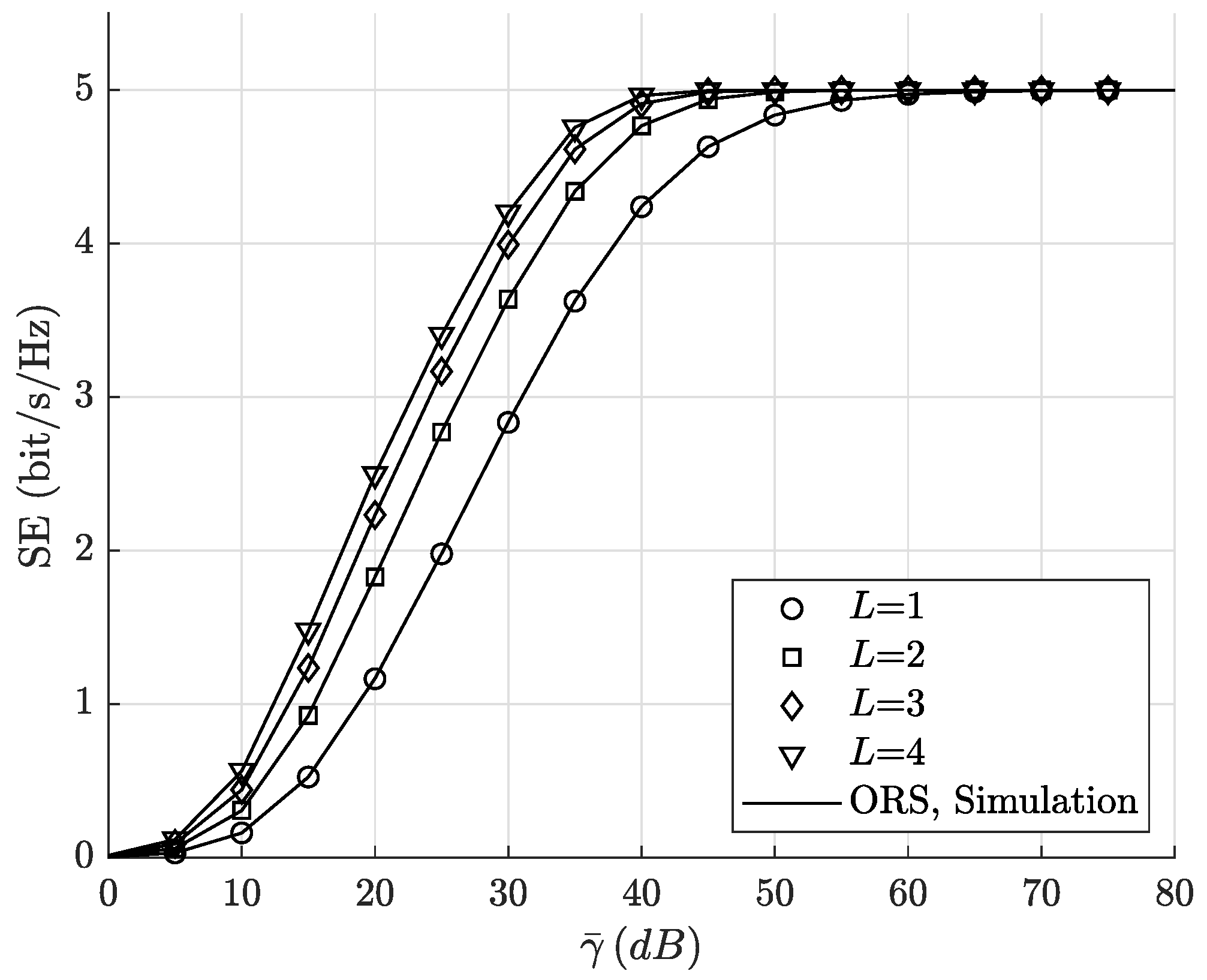
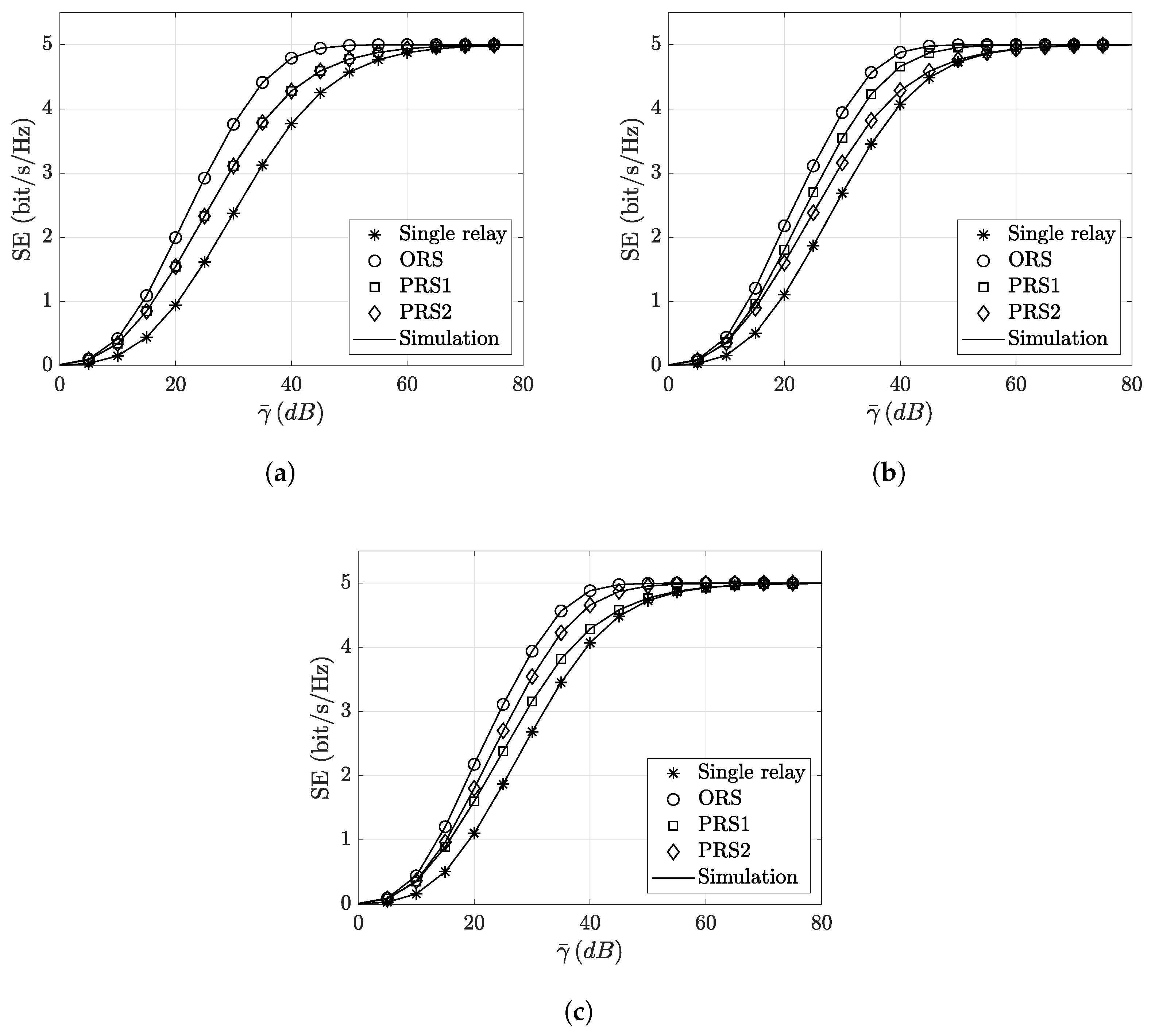
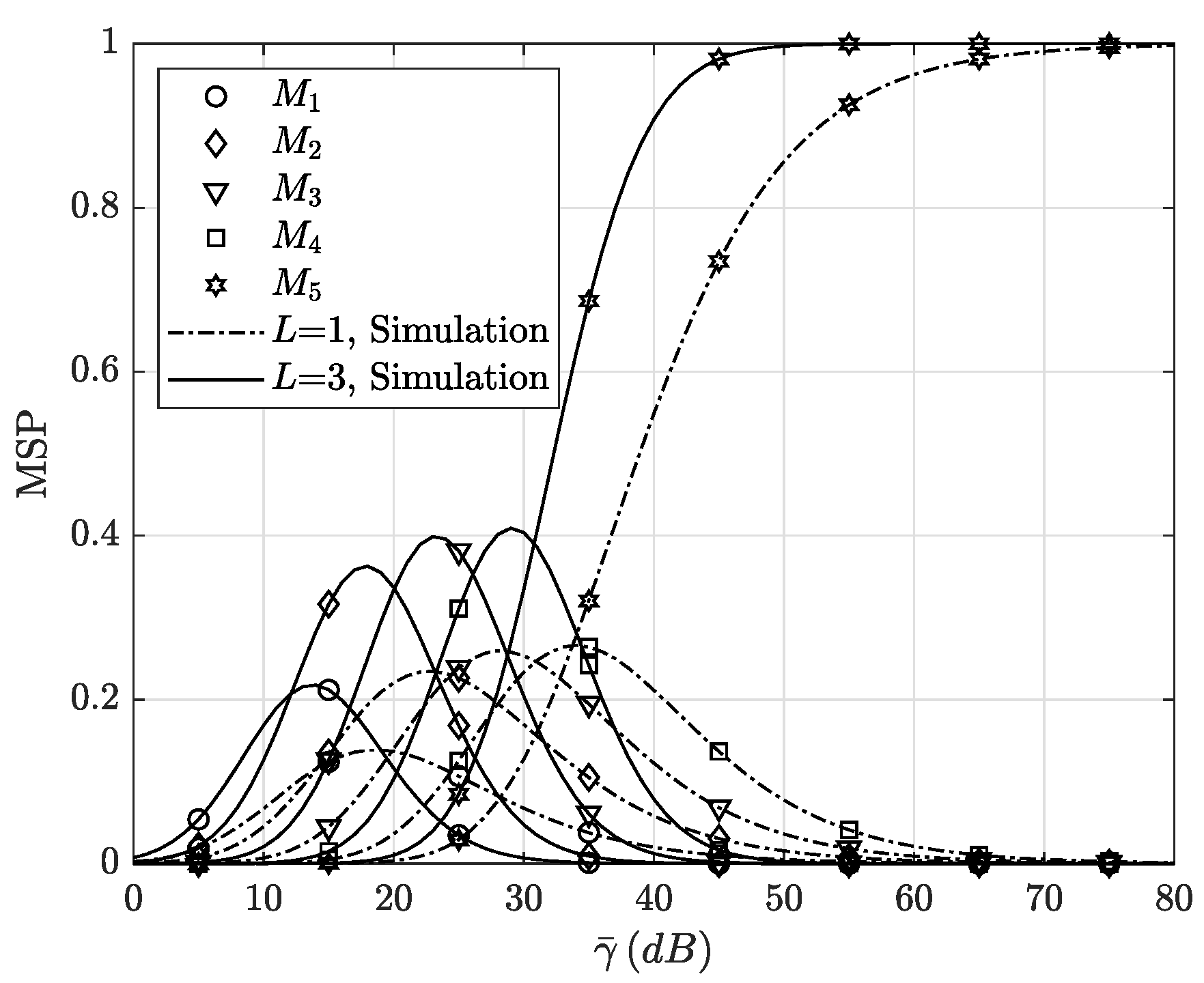
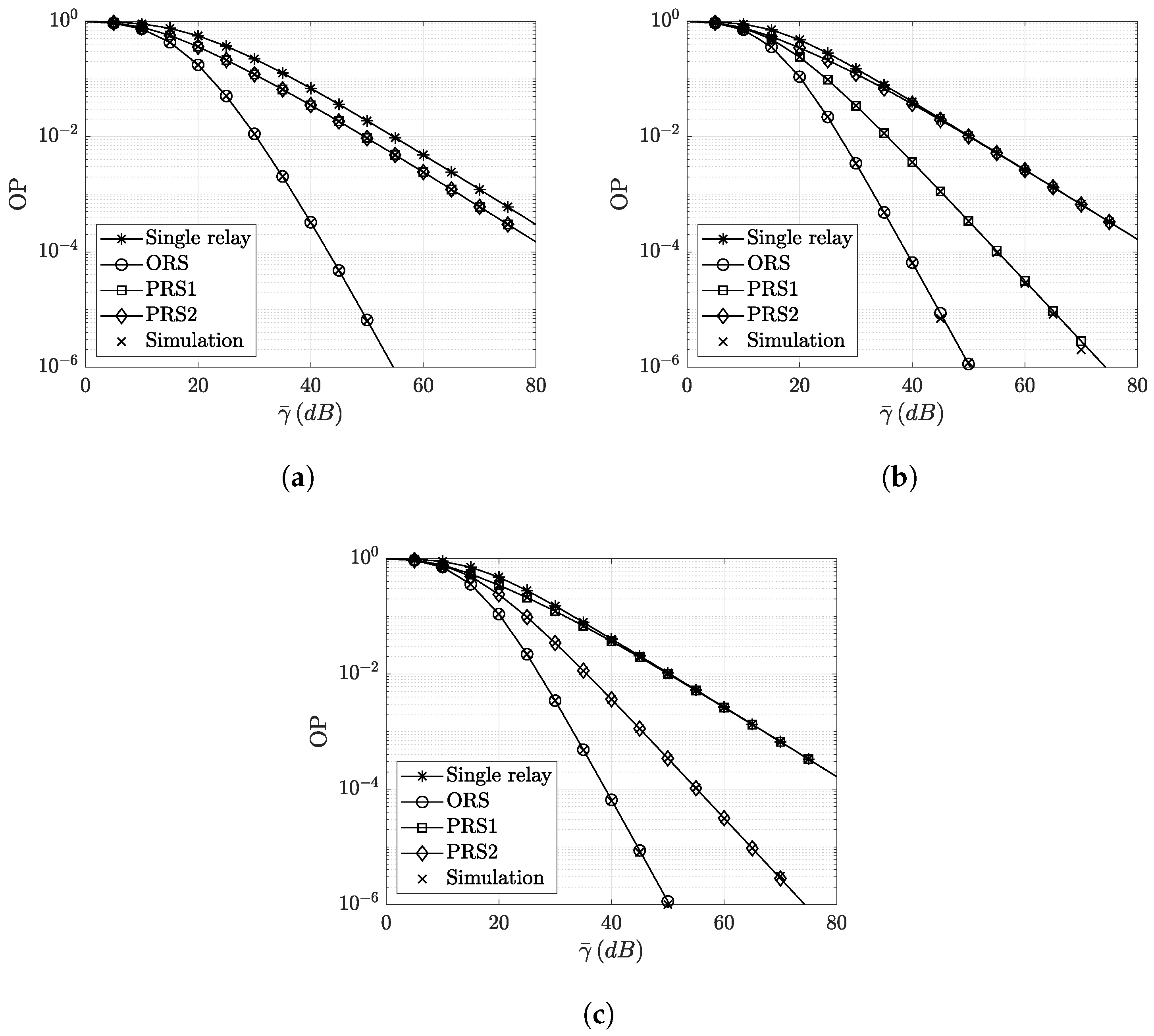
| Turbulence Condition | Case | ||||
|---|---|---|---|---|---|
| Strong turbulence | Balanced | 1.6795 | 1.6795 | 3.0746 | 3.0746 |
| Unbalanced-1 | 1.6102 | 2.0945 | 3.1128 | 3.3851 | |
| Unbalanced-2 | 2.0945 | 1.6102 | 3.3851 | 3.1128 | |
| Moderate turbulence | Balanced | 2.452 | 2.452 | 4.0912 | 4.0912 |
| Unbalanced-1 | 1.8573 | 4.2554 | 3.5841 | 5.6848 | |
| Unbalanced-2 | 4.2554 | 1.8573 | 5.6848 | 3.5841 | |
| Weak turbulence | Balanced | 3.4542 | 3.4542 | 5.1751 | 5.1751 |
| Unbalanced-1 | 2.3882 | 6.582 | 4.2057 | 7.9741 | |
| Unbalanced-2 | 6.582 | 2.3882 | 7.9741 | 4.2057 |
Disclaimer/Publisher’s Note: The statements, opinions and data contained in all publications are solely those of the individual author(s) and contributor(s) and not of MDPI and/or the editor(s). MDPI and/or the editor(s) disclaim responsibility for any injury to people or property resulting from any ideas, methods, instructions or products referred to in the content. |
© 2023 by the authors. Licensee MDPI, Basel, Switzerland. This article is an open access article distributed under the terms and conditions of the Creative Commons Attribution (CC BY) license (https://creativecommons.org/licenses/by/4.0/).
Share and Cite
Alathwary, W.A.; Altubaishi, E.S. Performance Analysis of Dual-Hop DF Multi-Relay FSO System with Adaptive Modulation. Appl. Sci. 2023, 13, 11035. https://doi.org/10.3390/app131911035
Alathwary WA, Altubaishi ES. Performance Analysis of Dual-Hop DF Multi-Relay FSO System with Adaptive Modulation. Applied Sciences. 2023; 13(19):11035. https://doi.org/10.3390/app131911035
Chicago/Turabian StyleAlathwary, Wagdy Ameen, and Essam Saleh Altubaishi. 2023. "Performance Analysis of Dual-Hop DF Multi-Relay FSO System with Adaptive Modulation" Applied Sciences 13, no. 19: 11035. https://doi.org/10.3390/app131911035






